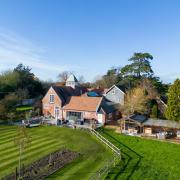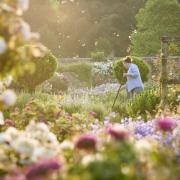Aside from the spring, when the garden begins to waken up and come into life, autumn is arguably the most beautiful time for our plants as fruits ripen and rich colours come to the fore. We get tips on creating an autumn haven
As you visit gardens this month take note of the wonderful array of trees and shrubs that star in the landscape through autumn. There are many to choose from that suit gardens both large and small, whether as stand alone specimens, in groups and copses, or combined with herbaceous plants. Observe the foliage hues, berries and bark while you select some favourites. The warm, rich colours of autumn are a delight to savour and bring a new dimension to the garden. As well as stunning deciduous trees, which draw the eye upwards, consider underplantings of shrubs, vines and perennials that provide subtle harmonies or striking contrasts of vibrant tones. Mother Nature ends the growing season with a flurry of colour, so it is well worth stepping out into the crisp air and paying a visit to nurseries, gardens or woodlands at this time of the year for a little bit of inspiration.

Autumnal foliage is highly anticipated on trees and shrubs. Acers and Japanese maples are among the best for fiery colour and suit small gardens, as does the rather lovely Cercis canadensis with its heart shaped leaves. Keep in mind that in general, less is more in a small space where you may like to draw the eye to a particular specimen tree, or in a larger garden you could create a grove of one or a range of species.

Berries epitomise the mellow, fruitfulness of autumn, decorate the garden, and many provide a vital food source for wildlife. A bonus is that most berry-producing trees and shrubs are easy to grow, don’t need much pruning and tolerate a range of soils and climatic conditions, including frost, wind and drought. There are choices for both large and small gardens, from towering sorbus to compact crab apples. If you have a tiny garden the best way to introduce berries may be to train or espalier against a wall, with ones such as glossy orange, red or yellow berried pyracantha or crimson cotoneaster. Think of it as painting a scene, mixing trees, shrubs, flowers and berries to create a stunning autumn canvas. Keep in mind that the intensity of foliage colour varies depending on how much rain and sunshine there was in summer, and is out of your control.

For a sense of the size and potential of mature trees take a visit to the naturalistic landscape of Exbury Gardens, which also holds national collections of nyssa and oxydendrum. Some ideas can be scaled down, such as underplanting a copse of glorious trees with tactile ferns, or adding a rustic bridge if planting by a stream. There are also areas of cultivated beds with a mix of late season perennials with berried and colouring shrubs to inspire ideas. At Sir Harold Hillier Gardens, another vast landscape to explore, there are champion trees in the arboretum, including blazing acers, and poplars, but also national collections of two of my favourites for a smaller garden, hamamelis (witch hazels) and cornus (dogwoods) planted with ornamental textural grasses to great effect.

To see how autumn shrubs and smaller trees can be mixed as part of a decorative scheme with herbaceous planting, a visit to West Green Garden is a must. Not only are there woodland strolls here but also dense borders designed for year-round interest, with richly mellow vignettes at this time of the year. Evergreen hollies laden with berries as backdrops to tufty asters and flamboyant dahlias, or crab apple branches glistening with jewels arching over the potager are further delights to savour. The sense of layering, from the tree canopy to groundcovers, accompanied with punctuation from clipped topiary evergreens is a master class.
November through to March is the perfect time to plant trees and shrubs, whether grown in containers, or the economical choice of bare root plants. Some may not be available in local garden centres and nurseries but will be online as bare root specimens, so do some hunting. If you are unfamiliar with bare root plants, the key word to remember is ‘dormant’. Deciduous plants go to sleep through winter; their cellular activity goes into almost complete hibernation. They shut down, needing just dampness of the roots to prevent cell damage, and requiring minimal maintenance.
Many deciduous trees, shrubs, hedging, roses, fruit trees and even some perennials are available as bare root plants, which simply means that there is no soil around the roots when delivered. This preparation method is often used to transport deciduous and some evergreen plants. They are generally one-to-three-year-old nursery stock, lifted, dug up by the grower from the fields, in their dormant stage, leafless, the soil is removed from the roots, and they are packaged ready to be replanted when you receive them. Buy from a reputable nursery to ensure the best quality and care. The RHS Find-a-Plant facility on the RHS website allows you to track down suppliers.
Pay a visit

Exbury Gardens, Exbury, SO45 1AZ
Open daily to 29 October (10am-5.30pm)
£15, children £5.50
exbury.co.uk
Sir Harold Hillier Gardens. Amplefield, Romsey, SO51 0QA
Open all year, except Christmas Day and Boxing Day (10am-5/6pm)
£13, children £3.75
hilliergardens.org.uk
West Green House Gardens, Hartley Wintney, RG27 8JB
Open Wednesday to Sunday until Oct 29 (11am-4.30pm) with Christmas activities from November 17 to December 23
Adults £10, children £5 or free to National Trust members
westgreenhouse.co.uk
Get the look

Trees for autumn foliage include acer, amelanchier, crataegus, fagus, fraxinus, liquidambar, malus, nyssa, parrotia, quercus, sorbus and tilia.
Shrubs with glorious autumn foliage include berberis, cercis, cornus, cotinus, disanthus, enkianthus, euonymus, fothergilla, hamamelis and viburnum.
For autumn berries try sorbus, crab apples, hollies, aronia, cotoneaster, pyracantha, callicarpa, physalis and ampelopsis.

Underplant with autumn-flowering bulbs, such as nerines, crocus, cyclamen and sternbergia.



























